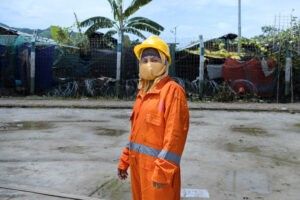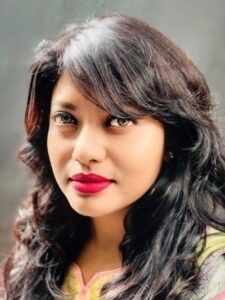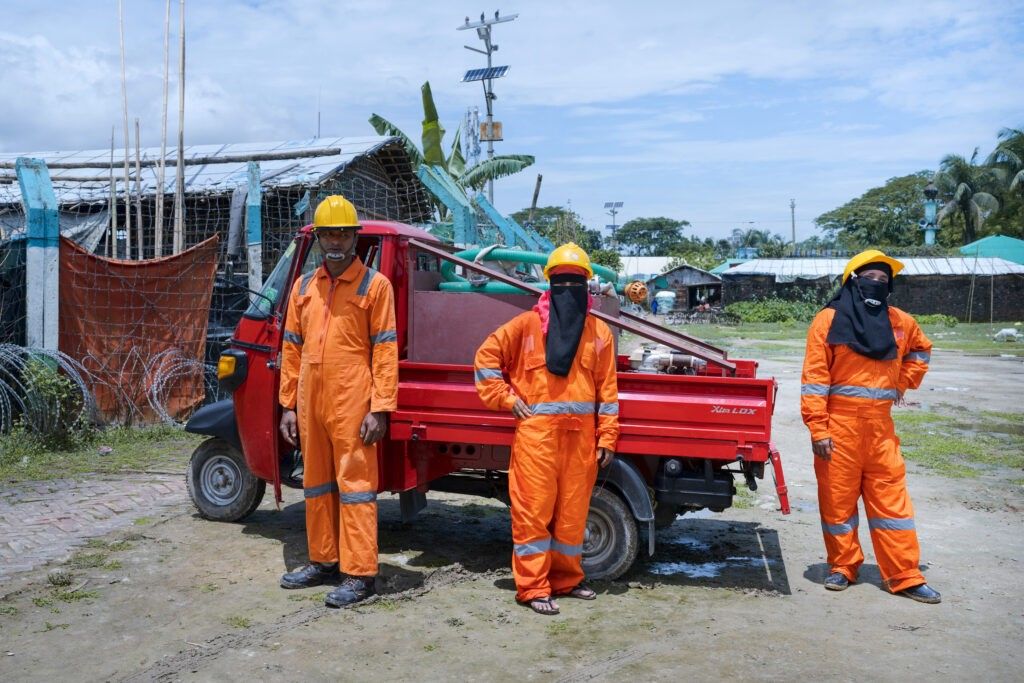A PHOTOGRAPHER has spoken of how she has charted the journey of Rohingya women “reclaiming their lives” in the refugee camps of Cox Bazaar in Bangladesh.
Fabeha Monir is among five women whose work will be displayed in an exhibition at the Oxo Tower Wharf gallery in London’s SouthBank.
The exhibition has been organised by international charity ActionAid UK, which aims to challenge stereotypes and celebrate inspiring women refugees from around the world.
Monir took photographs of women living in the world’s largest refugee settlement, Cox’s Bazar, home to nearly one million Rohingya who fled Myanmar’s Rakhine state. The 33 camps that make up the settlement are densely populated and services are overstretched. Located in southeast Bangladesh, the area is also prone to climate disasters, exposing the community to flooding, cyclones and landslides.

“These women have had to deal with a tremendous amount of trauma, but they are now taking control of their lives and helping others,” Monir told Eastern Eye.
She met women living in the camps who have become leaders in the community, undergoing training in areas including fire safety, first aid, cyclone preparedness, flood response and water safety.
“They received different types of training – for example, cyclone preparedness and fire incident response, which are not traditional things women are supposed to do in the community,” said Monir.
“I was thinking a lot about how I can bring the best image of them that will show the determination, the power and also the nurturing attributes they have in their character.
“Every time you will Google the Rohingya women in the refugee camp, you are going to see the same images. I wanted to portray them as they wanted to be portrayed. I wanted to tell the stories in a manner that was not like before, not in a straightforward way.”
Monir, who has been taking pictures of the women in the camps since 2017, said they were “very conservative”, but she noticed a change when she went to meet them this time around.
“They were extremely vulnerable, because they were very shy. They did not want to talk about their life, because they spent their life with a lot of trauma in Myanmar,” said Monir.

“When I went back to this year and talked to them again, they’re very inspiring characters. They have transformed their lives with the help of ActionAid and other organisations, which is the amazing part, of course, alongside all the ongoing challenges happening in that camp.”
One of the women Monir photographed was Amina.
“Amina is a fantastic swimmer, but since coming to the camp she didn’t swim because of the men,” said Monir.
However, this all changed when she saved the life of a young child who was drowning in the lake.
“Amina has gone on to train as a lifeguard. She realised she could play an important role in her community. She has gone on to save dozens of lives.”
Another woman, Rama, has lived in the refugee camp since 2012.
“I received training on cyclone preparedness, first aid treatment, fire safety, water safety and many other things,” said Rama.
“I like that I am working as a volunteer and doing something good for my community and people. Our community came here after experiencing trauma in Myanmar. Whenever I can do something for their good, I feel happy.”
Monir conceded that the refugees in the camp live in extremely challenging circumstances. But she hopes that seeing women like Rama in her orange high-vis clothing will go towards challenging some of the assumptions about these women.
“They are so strong,” she said. “We don’t get to see this side of them. They know they can be an important member of their community and they have decided to learn and use their knowledge to help others.”

As a photojournalist, Monir has had work published in the New York Times, the BBC, NBC, the Guardian, and Al Jazeera News.
Her work with international charities such as ActionAid gives her the unique position of being able to reach communities that others can’t.
“As a female journalist, I have immense access to the lives of women in our part of the world,” she said. “Violence against women has increased, homeless women and children are in greater danger, transgenders, sex workers, and the refugee community are suffering from this crisis.
“We need to continue our reportage highlighting the fight of the vulnerable who have no access to isolation or safety. In any system of oppression, the most vulnerable will always suffer the most and be heard the least.”
Monir said the Rohingya women had never been photographed before because there are very few female photo journalists and the refugees will not let men take their pictures.
“It’s a privilege for me to be able to take their photos and share their stories with others,” she said. “Every time I’m taking a picture, I ask myself how my stories can drive change.
“I feel like visual journalists like me can play an important role in providing vital information to communities, those that are affected by crisis. That’s why telling stories and making an impact is very important.”
The exhibition, titled Women by Women, which also features photographs of refugees living in Poland, Uganda, Colombia and Turkey. It aims to highlight the need for more funding for womenled organisations, which currently receive just one per cent of gender equality funding. By showcasing the diverse range of refugee experiences, Women by Women hopes to change societal attitudes towards people seeking sanctuary.
Taahra Ghazi, director of innovation at ActionAid UK, said: “Portrayal of refugees, particularly in the media, should be with impartiality, dignity, and humanity. We must create more space for refugee women to tell their own unique stories and celebrate their special contributions to their host communities.
“In doing so, we shine a light on the incredible women-led organisations that are an invaluable lifeline to women refugees, in the hope that their chronic underfunding is addressed so they can continue to uplift and empower women refugees.”
The Women by Women photography exhibition takes place at gallery@oxo, Oxo Tower Wharf, in London’s South Bank, from Thursday (7) until Sunday (10). Opening hours are 11am to 6pm, admission is free of charge.
